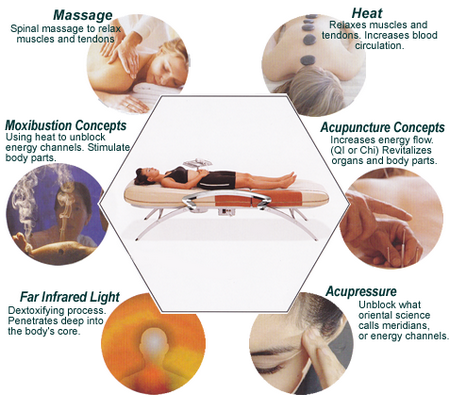Anyone who has ever suffered a headache or sinus trouble and has found some relief by putting gentle pressure on the area that is causing pain has tried acupressure in its simplest form. But the actual training of acupressure is a lot more complex.
Acupressure has been in use for thousands of years, and was a feature of all the great Oriental medical traditions. Pressure and massage are used with usually the fingertips on various points along the body’s meridians – invisible or electrical – channels. It is believed that these meridians carry the energy or life force, known as Qi (pronounced chee) through the body. Mental, physical, emotional and spiritual health is balanced by the opposing but complementary forces of yin and yang. When these forces become unbalanced, then illness or disease follows. Pressure on points along these meridians help to restore the life force and so health. Traditional Chinese practitioners believe there are 365 points along the 14 meridians, but more modern practitioners have found up to 2000 points to help treat every ailment.
How the therapy works
As with acupuncture, once diagnosis has been made, pressure is put on certain points along the body. This can vary in combination and from light touch, such as in Shen Tao, to firm pressure, such as in Shiatsu, depending on your child’s problem. Your child may be asked to he on a mattress or padded table and pressure will be exerted, with the fingers and thumbs, or sometimes hands, elbows, knees or feet. It may be slighdy uncomfortable, but shouldn’t be painful.
Light acupressure can easily be used at home. If you are treating your child at home, make sure they are warm and relaxed before you start. If you are not sure of their ailment, always consult a doctor or practitioner before applying any pressure.
What to expect from a first visit
A practitioner will first discuss your child’s condition and why you have come. Detailed notes will be taken, including general health, family medical history, personality traits, diet, bowel movements and so on, to build up an overall picture. They will then look at your child’s tongue, seen as a strong indicator of overall health, checking its colour, texture and coating. The Chinese believe there are twelve pulses, six on each wrist, which relate to the energy of the body’s organs and functions and these will also be checked. Pressure will then be applied to the appropriate points. This may take around forty-five minutes.
Finding a therapist
The practitioner should be trained to the same high standard as an acupuncturist and training should include anatomy, physiology, pathology and diagnosis. Always ask the practitioner what experience they have of treating children as this is a specialist field and experience is advisable. Personal recommendation is also one of the best methods of finding a therapist.
Qualifications
Many practitioners – those trained in acupuncture, Shiatsu, Shen Tao and so on – practise acupressure, so the qualifications will vary.
Use with other therapies
Other therapies, such as the Alexander Technique, osteopathy, chiropractic and Chinese herbal medicine may all work well with acupressure, depending on the ailment.
Any dangers
Acupressure can be safely used at home for problems such as headaches and stress. However, overstimulation can temporarily make the symptoms worse. Rather than just trying pressure on sore points, it is better to gain guidance from a qualified practitioner or use a good book. If you are in any doubt about your child’s symptoms, always consult your GP. Certain points are contraindicated during pregnancy.
How much will it costs
A first consultation may be around £25, depending on which area of the country you live in.
Availability on the NHS
Not specifically available, but may be used in conjunction with acupuncture.
